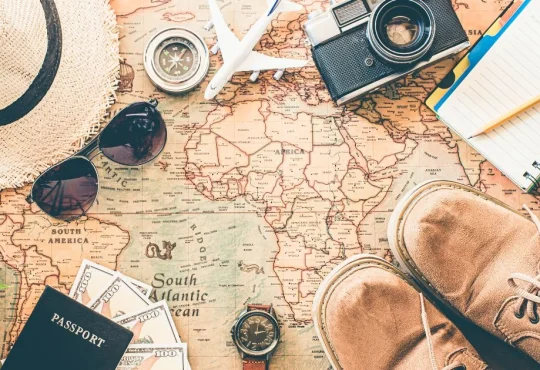
Planning an accessible trip can come with unique challenges. However, with thoughtful preparation and practical tips for accessible travel, a rewarding experience is well within reach, whether traveling with someone with a temporary or permanent disability; researching and planning are essential steps for a smooth journey. Although the Americans with Disabilities Act (ADA) provides accessibility standards within the U.S., these guidelines may not apply abroad, making it vital to research accessibility in each destination. Resources like Mobility International USA and Curb Free with Cory Lee offer valuable insights into accessible locations and logistics, helping travelers focus on the adventure ahead.
When planning for accessible travel, it’s essential to consider the unique needs of travelers with disabilities. This includes selecting suitable accommodations and arranging airport assistance. Careful planning allows tailored itineraries that accommodate energy levels and daily routines, ensuring a comfortable and enjoyable experience for travelers and their caregivers. By focusing on tips for accessible travel and seeking expert advice, individuals can enjoy exploring new destinations without facing unnecessary obstacles, creating memorable journeys filled with adventure and discovery.
Tips for Accessible Travel for People with Disabilities
1. Plan Ahead
Traveling with someone who has a physical disability requires thoughtful planning since the challenges are often similar, regardless of the disability’s duration. For U.S.-based travel, the Department of State and ADA offer valuable information on accessibility standards. However, ADA compliance doesn’t apply internationally, so don’t assume accommodations abroad will meet these standards. Call ahead to discuss accessibility options directly with the hotel or transportation provider. Resources like Mobility International USA and Curb Free with Cory Lee cover topics from wheelchair battery charging to traveling with a service animal, offering a wealth of tips for accessible travel worldwide.
2. Stick to Familiar Routines
Timothy Holtz, the group travel director at Flying Wheels Travel—an agency specializing in travel for people with disabilities and chronic illnesses—emphasizes the importance of tailoring itineraries to the energy levels and routines of the traveler. If the person in a wheelchair feels most energetic in the morning, plan major activities then. Holtz also recommends not overloading the schedule to avoid burnout. He suggests travelers stick to their usual routines, such as napping if it’s part of the daily schedule, as this can make all the difference in having a comfortable and enjoyable trip.
3. Make Sure Travel Insurance Covers Medical Needs
Some travel insurance only covers financial losses, and Medicare doesn’t extend coverage overseas. Check the Department of State for a list of recommended medical providers, and choose a policy with medical evacuation coverage (medevac) in case of emergencies; this coverage can save substantial costs if needed.
4. Use a Specialized Travel Agency
Specialized travel agents can craft accessible itineraries for popular destinations worldwide, from Bali to the Galapagos Islands, even if accessibility varies. Experienced agents know which hotels are accessible and can arrange transportation to less accommodating destinations. Holtz, for example, has facilitated trips to places like Machu Picchu by customizing accommodations, such as adding grab bars in showers and sharing accessible destination recommendations. He notes that London and Barcelona are especially wheelchair-friendly in terms of their Olympic and Paralympic histories. Italy is a favorite for group trips, though it requires extra planning—Venice, for example, has wheelchair-accessible boats, including a recently introduced accessible gondola.
5. Enroll in STEP
The State Department’s Smart Traveler Enrollment Program (STEP) lets you register your trip with the local U.S. Embassy, ensuring emergency updates. The program also has a section that notes any physical limitations.
6. Book Accessible Accommodations
When booking a hotel, look for amenities similar to those used at home. For example, if a roll-in shower with a bench is needed, ask the hotel about this feature. Some international hotels may misunderstand accessibility needs, so it’s best to confirm details, like door widths and whether a wheelchair can easily maneuver within the room.
7. Arrange Airport Assistance
Allow extra time when flying and arrange wheelchair assistance with the airline in advance, double-checking 48 hours prior. Remind staff at check-in and the gate for smooth boarding and faster security checks. If traveling with a personal wheelchair, remove any detachable items to prevent loss. On U.S. flights, request an aisle seat near the restroom, as most airlines provide an aisle wheelchair for accessible bathrooms.

8. Decide Whether to Bring or Rent a Wheelchair
Consider comfort and convenience when deciding whether to bring a wheelchair or arrange one at the destination. While familiar comfort is a plus, electric wheelchairs require charging considerations. Review travel regulations with the U.S. Department of Transportation and know the rules at your destination.
9. Take Advantage of Travel Discounts
Discounts for travelers with disabilities are available through Amtrak, Greyhound, and many international transport services—the National Park Service Access Pass grants citizens with permanent disabilities free access to U.S. parks. Museums, zoos, and theme parks often offer discounts, too.
10. Remember the Caregiver’s Needs
Holtz advises factoring in the caregiver’s stamina, as they may need time to rest if helping with daily routines like morning preparations and taking a balanced approach to sightseeing benefits both the caregiver and the traveler. Agencies like Flying Wheels Travel even offer companion services, allowing caregivers or spouses to enjoy the trip without feeling overextended.
In planning an accessible trip, thoughtful preparation can make all the difference in creating a smooth, enjoyable experience for everyone involved. From understanding international accessibility standards to crafting an itinerary that matches energy levels and routines, each step plays a crucial role. Specialized resources like Flying Wheels Travel, Mobility International USA, and Curb Free with Cory Lee provide valuable insights for accessible travel, while programs like STEP and services for airport assistance add layers of support and security.
Prioritizing the comfort and needs of travelers and caregivers ensures that the journey is enriching and relaxed, allowing everyone to focus on the adventure ahead. With a bit of research and organization, accessible travel becomes not only feasible but thoroughly enjoyable.
Top Disability-Friendly Destinations
When evaluating the best destinations for individuals with disabilities, certain regions and countries emerge due to their vital infrastructure, inclusive policies, and commitment to accessibility.
Europe’s Best
Berlin, Germany, stands out for its significant investment in accessibility, featuring tactile pavements, ramps, and comprehensive public transportation options. These initiatives facilitate easy navigation for people with disabilities throughout the city.
Scandinavia is notable for its accessible environments, particularly in Sweden and Denmark, where public spaces like parks and museums have ramps and elevators. Accessible restrooms are common, and public transportation includes features such as audible announcements for the visually impaired.
France has made remarkable advancements in accessibility, especially in major cities like Paris. Iconic tourist attractions, including the Louvre and the Eiffel Tower, have implemented ramps and lifts for wheelchair users. Public transportation also prioritizes accessibility, allowing for smoother travel experiences.
North America’s Finest
The United States has long been a pioneer in disability rights and infrastructure. Cities like Seattle and Denver are exemplary, offering accessible public services. Seattle’s public transportation system has ramps and low-floor buses, while public buildings feature wide entryways and elevators.
Canada is another accessibility model, with cities like Vancouver and Toronto leading the way. Vancouver’s public transportation includes wheelchair ramps, and many businesses have retrofitted to enhance accessibility. Public buildings such as libraries and community centers are designed to be inclusive.
Pioneers in Asia and Oceania
Japan is a top destination for accessibility in Asia, with cities like Tokyo and Kyoto investing heavily in inaccessible infrastructure. Public transportation systems provide elevators and tactile paving, and hotels offer accessible accommodations, focusing on removing barriers for disabled visitors.
Australia, particularly in Melbourne and Sydney, has implemented comprehensive accessibility policies. Public buildings like theaters and museums have been adapted for full accessibility, and transportation systems feature low-floor trams and buses to ensure convenience for all travelers.
Notable Mentions
Brazil, especially Rio de Janeiro, is recognized as a disability-friendly destination in South America. The city’s public transportation system includes lifts and tactile floors for the visually impaired, while accessibility features are integrated into tourist attractions, beaches, and public buildings.
Mexico has made significant strides toward greater accessibility, particularly in cities like Mexico City and Cancun. Ongoing upgrades to public transportation and sidewalks enhance mobility for wheelchair users and those with other disabilities, while parks and museums frequently include ramps and accessible restrooms.
A Comprehensive Guide to Planning Accessible Trips
In conclusion, the key to a successful accessible trip lies in thorough preparation and awareness of the specific needs of travelers with disabilities. Understanding international accessibility standards and crafting an itinerary that respects personal routines can significantly enhance the travel experience. Specialized resources, such as travel agencies focusing on accessibility and informative websites, offer invaluable support in navigating potential challenges. Programs like the State Department’s Smart Traveler Enrollment Program (STEP) provide added peace of mind, ensuring travelers access important updates during their journey.
Ultimately, planning an accessible trip should be approached with a positive outlook, recognizing the opportunities for exploration and enjoyment that await. By carefully considering the needs of travelers and their caregivers, everyone can fully engage in their adventures, discovering the world with ease and comfort. With a bit of diligence and creativity, accessible travel can be possible and a source of joy and enrichment for all involved.





